Dactyloplusia is a monotypic moth genus of the family Noctuidae erected by Chou Io and Lu Chinsheng in 1979. Its single species, Dactyloplusia impulsa, was first described by Francis Walker in 1865. It is found in Sri Lanka, India, southern China, Sundaland, Sulawesi, New Guinea, Fiji and Australia.
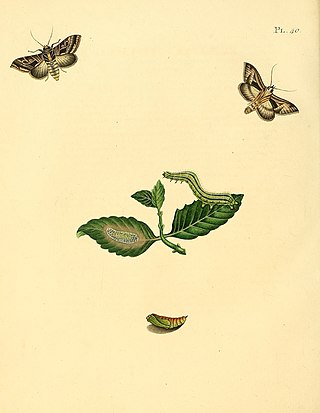
Enigmogramma is a genus of moths of the family Noctuidae.
Mosopia is a genus of moths of the family Erebidae. It is found in south-east Asia, including Thailand, Borneo and Malaysia. The genus was first described by Francis Walker in 1866 from a specimen in the British Museum. The specimen Walker describes was from Penang in Malaysia.

Ichneutica insignis is a moth of the family Noctuidae. It is endemic to New Zealand. This species is found throughout New Zealand, although it appears to be scarce in inland sites of tussock grasslands. The adults are on the wing throughout the year. It is a variable species and as such can be easily confused with I. skelloni and I. plena. The larvae of this species have been recorded as feeding on Trifolium pratense.
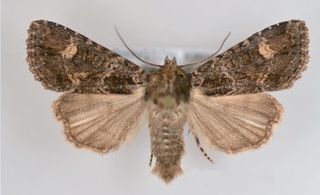
Aseptis binotata, the rusty shoulder knot moth, is a moth of the family Noctuidae. The species was first described by Francis Walker in 1865. It is found widespread in western North America, west of south-central Alberta, Wyoming, and Nebraska. Along the Pacific Coast it occurs from northern Mexico to south-central British Columbia. It can be found from sea level to altitudes over 2000 meters in a variety of habitats from dense forest to shrub desert.

Allagrapha aerea, the unspotted looper moth or copper looper moth, is a moth of the family Noctuidae. The species was first described by Jacob Hübner in 1803. It is found in eastern North America from southern Ontario to the Florida Panhandle and west to western Nebraska.
Chrysanympha formosa, the Formosa looper, is a moth of the family Noctuidae. The species was first described by Augustus Radcliffe Grote in 1865. It is found in North America from Newfoundland west to Manitoba and south to the mountains of North Carolina and Tennessee.
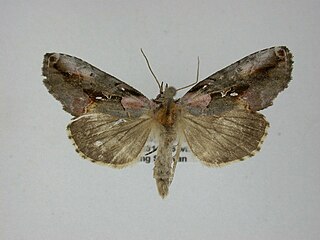
Eosphoropteryx thyatyroides, the pink-patched looper moth or pink-tinted beauty, is a moth of the family Noctuidae. The species was first described by Achille Guenée in 1852. In North America it is found from Nova Scotia and northern Ontario south to Minnesota, Michigan, Ohio and along the Appalachians from Maine to eastern Tennessee and western North Carolina; and to the west, it occurs from central Alberta and southern British Columbia, south in the Cascades to southern Oregon, and in the Rocky Mountains to northern Idaho.

Heliothinae is a small, cosmopolitan subfamily of moths in the family Noctuidae, with about 400 described species worldwide. It includes a number of economically significant agricultural pest species, such as Helicoverpa armigera and Helicoverpa zea.
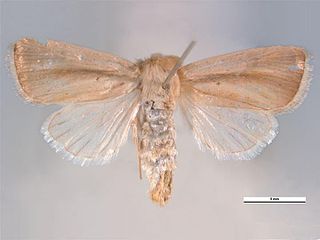
Sesamia inferens, the Asiatic pink stem borer, gramineous stem borer, pink borer, pink rice borer, pink rice stem borer, pink stem borer, purple borer, purple stem borer or purplish stem borer, is a moth of the family Noctuidae. The species was first described by Francis Walker in 1856. It is found from Pakistan, India, Sri Lanka, Myanmar to Japan and the Solomon Islands. A polyphagous species, it is a major pest in many crops worldwide.
Enigmogramma admonens is a moth of the family Noctuidae first described by Francis Walker in 1858. It is found in Brazil, Cuba and Puerto Rico.
Enigmogramma antillea is a moth of the family Noctuidae. It is found on Cuba and Puerto Rico. A specimen was collected in Collier County, Florida, in 2012.
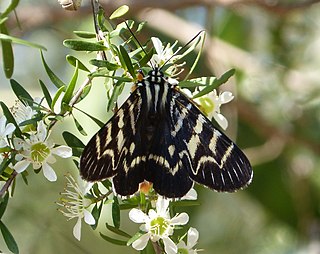
Comocrus is a monotypic moth genus in the family Noctuidae erected by Karl Jordan in 1896. Its only species, Comocrus behri, the mistletoe moth or mistletoe day moth, was first described by George French Angas in 1847. It is widely distributed in southern Australia from Perth to Melbourne and adjacent to Bass Strait, occurring as far north as Derby, Western Australia, and Clermont and Rockhampton in Queensland. It may be seen during daylight hours hovering around mistletoe species such as Amyema miquelii, Amyema melaleucae and Amyema cambadgei growing on Casuarina and Eucalyptus trees. The adult moths feed on Eucalyptus flower nectar, have a wingspan of some 58 millimetres and are basically black with white bands running through the wings. Individuals ready to mate exhibit 'hill-topping' behaviour, flying to high points in the landscape and there encountering mates.
Teulisna basigera is a moth of the family Erebidae first described by Francis Walker in 1865. It is found in India.

Diomea rotundata is a moth of the family Noctuidae first described by Francis Walker in 1857. It is found in Sri Lanka, the Indian subregion, Taiwan, Sumatra, Borneo, the Philippines and Sumba.
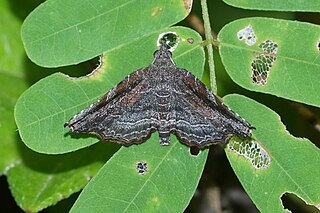
Nagadeba indecoralis is a moth of the family Noctuidae first described by Francis Walker in 1865. It is found in Sri Lanka, Java, India, Myanmar, India's Andaman Islands, Japan and Taiwan.
Radara subcupralis is a moth of the family Noctuidae first described by Francis Walker in 1866.
Rabila frontalis, the red bollworm, is a moth of the family Noctuidae. The species was first described by Francis Walker in 1865. It is found in India and Sri Lanka.

Anigraea cinctipalpis is a moth of the family Noctuidae first described by Francis Walker in 1865. It is found in Indian subregion, Sri Lanka, Malaysia, Borneo, Philippines, New Guinea and Australia.
Feliniopsis opposita is a moth of the family Noctuidae first described by Francis Walker in 1865. It is found in Kenya, Somalia, Sri Lanka and India.












